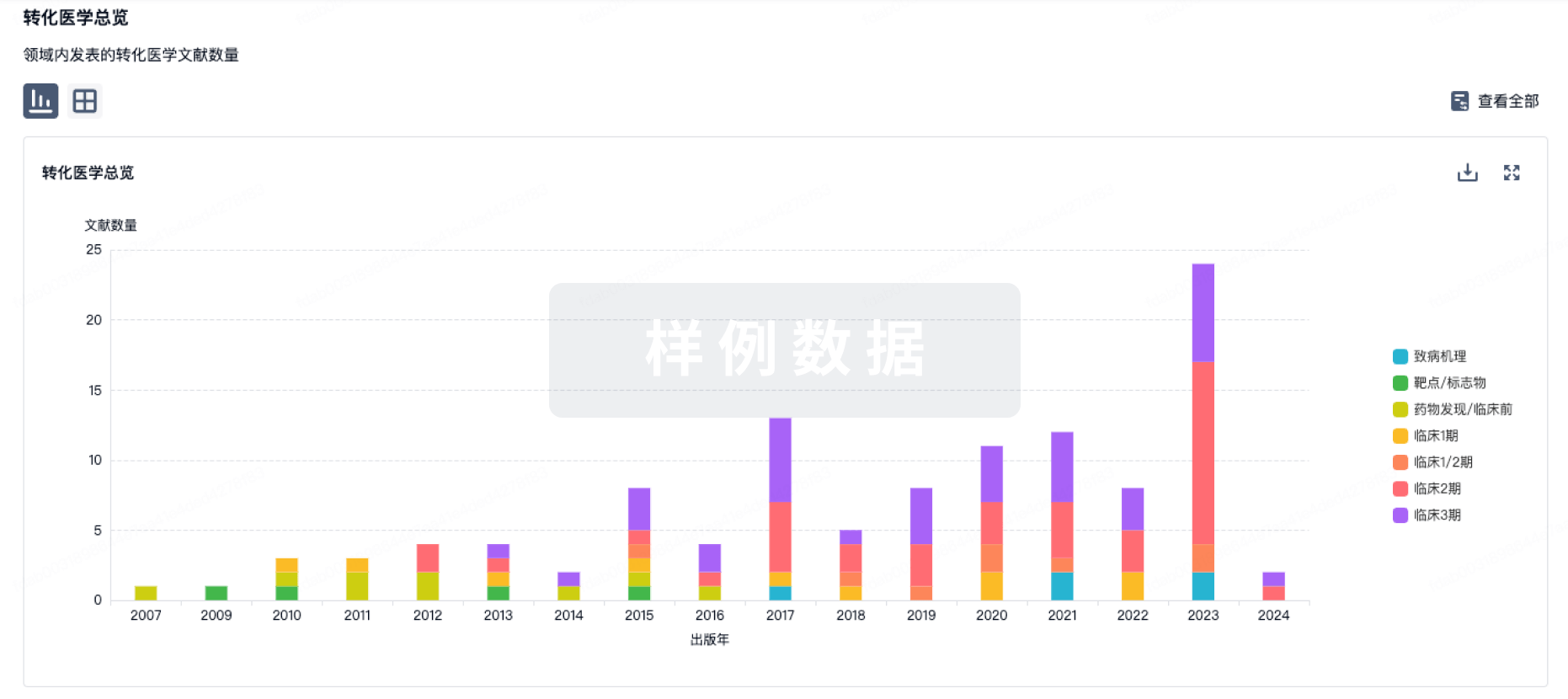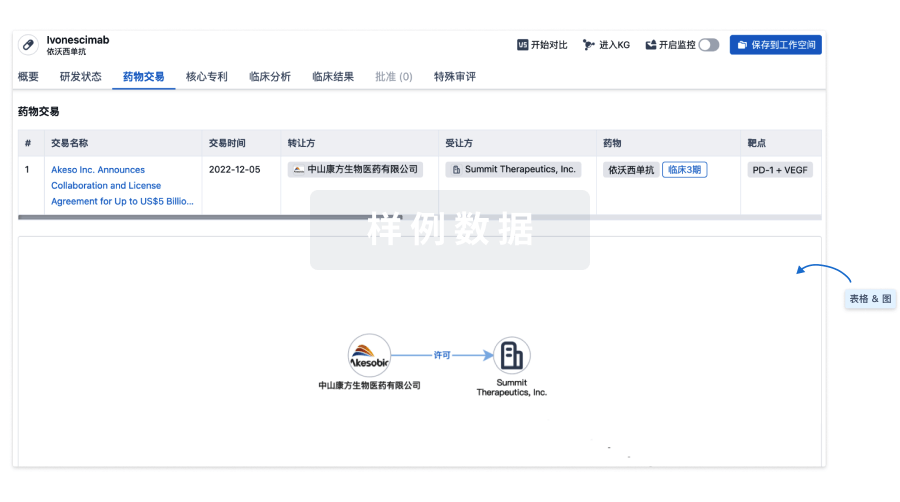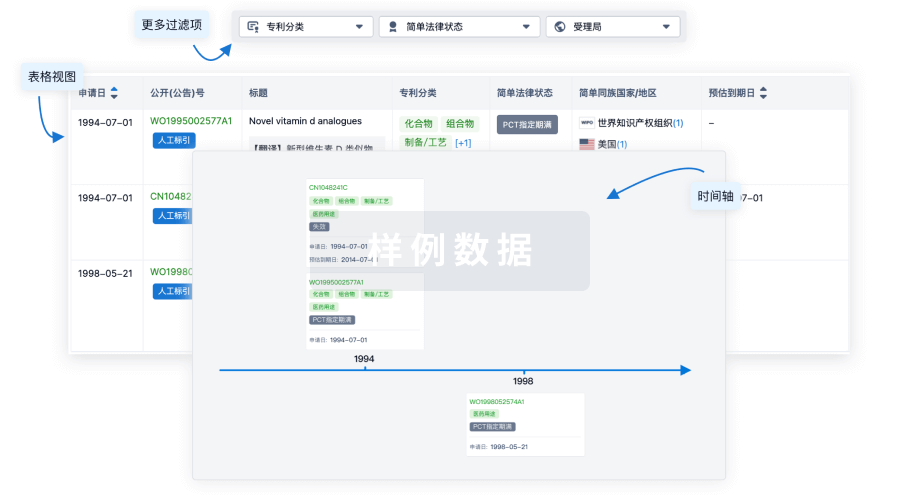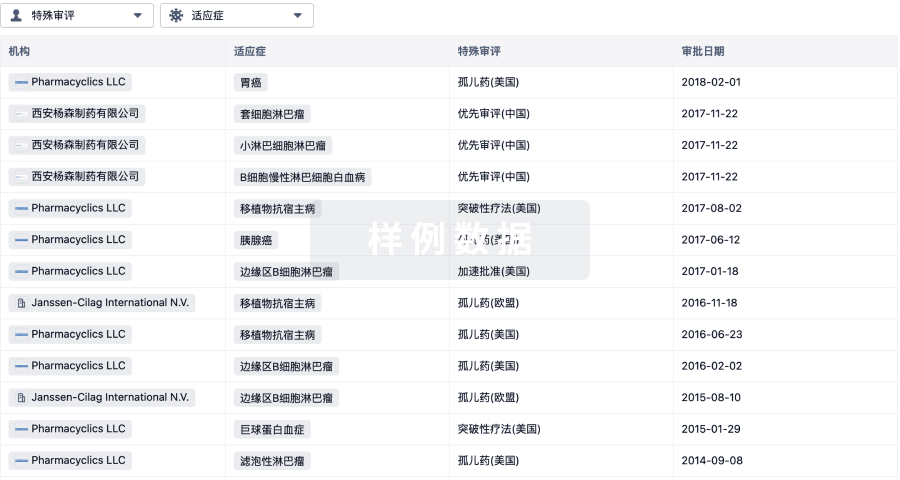预约演示
更新于:2025-09-13
Autologous anti-CD19 CAR-T cells expressing a shRNA against IL-6(Shanghai Unicar)
沉默白介素6表达功能的靶向CD19基因工程化自体T细胞(上海优卡迪)
更新于:2025-09-13
概要
基本信息
药物类型 自体CAR-T |
别名 ssCART-19、ssCART-19 cells、ssCART-19(Shanghai Unicar) + [2] |
靶点 |
作用方式 抑制剂 |
作用机制 CD19抑制剂(B淋巴细胞抗原CD19抑制剂) |
非在研适应症 |
原研机构 |
非在研机构- |
权益机构- |
最高研发阶段临床2期 |
首次获批日期- |
最高研发阶段(中国)临床2期 |
特殊审评孤儿药 (美国) |
登录后查看时间轴
关联
10
项与 沉默白介素6表达功能的靶向CD19基因工程化自体T细胞(上海优卡迪) 相关的临床试验NCT06987916
A Single-Arm, Open-Label Clinical Study on the Efficacy and Safety of U01 (ssCART-19) in the Treatment of Relapsed or Refractory B-Cell Lymphoma
This is an open-label phase1 study to assess the safety and efficacy of U01(ssCART-19) cell therapy in the treatment of patients with refractory or recurrent B-cell lymphoma .
开始日期2025-04-22 |
申办/合作机构 |
NCT07093073
A Single-arm, Open-label Clinical Study Evaluating the Efficacy and Safety of U01 (ssCART-19) in Patients With Relapsed or Refractory B-cell Lymphoma.
This is a single-arm, open-label clinical study evaluating the efficacy and safety of U01 (ssCART-19) in patients with relapsed or refractory B-cell lymphoma.
开始日期2025-01-23 |
申办/合作机构 |
NCT06367114
Phase Ⅱ Clinical Trial of ssCART-19 Cell Injection in the Treatment of CD19 Positive Relapsed or Refractory Acute Lymphoblastic Leukemia (Including Central Nervous System Infiltration)
This study is a Phase II, single-arm, open-label, non-randomized, dose-escalation clinical trial to evaluate the efficacy and safety of ssCART-19 Cell Injection in the treatment of patients with CD19 positive Relapsed or Refractory acute lymphoblastic leukemia, including central nervous system infiltration.
开始日期2024-04-01 |
申办/合作机构  上海优卡迪生物医药科技有限公司 上海优卡迪生物医药科技有限公司 [+2] |
100 项与 沉默白介素6表达功能的靶向CD19基因工程化自体T细胞(上海优卡迪) 相关的临床结果
登录后查看更多信息
100 项与 沉默白介素6表达功能的靶向CD19基因工程化自体T细胞(上海优卡迪) 相关的转化医学
登录后查看更多信息
100 项与 沉默白介素6表达功能的靶向CD19基因工程化自体T细胞(上海优卡迪) 相关的专利(医药)
登录后查看更多信息
49
项与 沉默白介素6表达功能的靶向CD19基因工程化自体T细胞(上海优卡迪) 相关的文献(医药)2025-12-01·WATER RESEARCH
Freeze–thaw–induced regulation of petroleum hydrocarbon adsorption in cold-region soils: Role of organic matter dynamics
Article
作者: Su, Xiaosi ; Lyu, Hang ; Dong, Weihong ; Zhong, Rong ; Shen, Xiaofang ; Yan, Xinyue ; Wan, Yuyu ; Song, Tiejun ; Teng, Yun
Numerous global regions are increasingly exposed to environmental risks from oil extraction and transportation, where contaminated soils are frequently subjected to seasonal and diurnal freeze-thaw cycles (FTCs). As a key interfacial process, soil adsorption can regulate the fate and mobility of petroleum hydrocarbons (PHCs), whereas the effect of FTCs on PHC adsorption remains poorly understood. This study integrated in-situ freeze-thaw treatments with adsorption experiments to examine the freeze-thaw effects on soil properties and their influence on the adsorption of representative PHCs under varying hydrothermal conditions. The results demonstrated that FTCs exert contrasting effects on the adsorption of non-polar and polar PHCs. The repeated ice-water phase transitions reduced the C-H functional groups on soil surfaces and increased the competition from dissolved organic carbon (DOC), thereby diminishing the adsorption capacity for non-polar PHCs. In contrast, the freeze-thaw processes enhanced the soil specific surface area and -OH functional group abundance, promoting the adsorption of polar PHCs. Moreover, precipitation and temperature fluctuations intensified these effects by introducing exogenous organic matter and accelerating soil aggregate disintegration and DOC release, which further suppressed non-polar PHC adsorption while enhancing that of polar PHCs. The directionality of hydrothermal variation also influenced the adsorption behavior. Compared with the autumn freeze-thaw processes, the spring processes initiated from a frozen state facilitated the conversion of soil organic carbon to DOC and the accumulation of humic substances during warming, thereby enhancing the polar PHC adsorption and suppressing that of non-polar PHCs. These findings provide a theoretical basis for the risk assessment and remediation of PHC-contaminated soils in cold regions.
2025-03-01·JOURNAL OF PHARMACEUTICAL AND BIOMEDICAL ANALYSIS
Deeper insights into the stability of oxylipins in human plasma across multiple freeze-thaw cycles and storage conditions
Article
作者: Sáiz, Jorge ; Barbas, Coral ; Gradillas, Ana ; Taha, Ameer Y ; Camunas-Alberca, Sandra M ; Moran-Garrido, Maria
Oxylipins are signaling lipids derived from the oxidation of polyunsaturated fatty acids (PUFAs). In lipidomic studies, human plasma may be subjected to various storage conditions and freeze-thaw cycles, which may impact the analysis of these compounds. In this study, we used liquid chromatography coupled with mass spectrometry (LC-MS) to examine the influence of up to five freeze-thaw cycles (FTCs) on free and total (mostly esterified) oxylipins in human plasma and the influence of temperature and storage duration (4 °C for up to 120 h and -20 °C and -80 °C for 1-98 days) in the presence or absence of butylated hydroxytoluene (BHT) on extracted oxylipins stored in LC-MS amber vials. In fresh plasma subjected to several FTCs, approximately 48 % of the detected free oxylipins were significantly altered by the third cycle, with increases in cytochrome P450 (CYP450) and lipoxygenase (LOX)-derived compounds and reductions in trihydroxylated oxylipins. In contrast, multiple FTCs did not significantly alter esterified oxylipins. At 4 °C, the extracted oxylipins did not change significantly for up to 120 h (5 days). Oxylipin levels remained stable for 98 days at -80 °C but decreased by 98 days at -20 °C. The antioxidant activity of butylated hydroxytoluene (BHT) did not influence oxylipin stability at 4 °C for 120 h or at -80 °C for 98 days, but it reduced oxylipin degradation at -20 °C at 98 days. Conversely, prostaglandin F2α (PGF2α) exhibited substantial increases at -20 °C and -80 °C, independent of BHT. This study demonstrates that (i) unlike free oxylipins, the esterified oxylipin pool remains stable following repeated FTCs, (ii) extracted oxylipins are stable at 4 °C for up to 120 h and at -80 °C for up to 98 days, but not at -20 °C for 98 days, and (iii) BHT may minimize oxylipin degradation of sample extracts stored at -20 °C. This study provides a framework for measuring oxylipins under various freeze-thaw and storage conditions.
2025-02-01·SCIENCE OF THE TOTAL ENVIRONMENT
Freeze-thaw cycles affect hydrothermal and heavy metal transport mechanisms in porous media: Closed and transient flooded system conditions
Article
作者: Fu, Qiang ; Li, Mo ; Li, Tianxiao ; Zhao, Chengye ; Meng, Fanxiang ; Liu, Dong
Freeze-thaw cycles (FTCs) are one of the main drivers of soil heavy metals (HMs) migration. Soil hydrothermal and HMs migration are closely related, and the hydrothermal environments studied so far are relatively homogeneous and the effects of stagnant water infiltration during freeze-thaw periods are not sufficiently explored. To overcome this limitation, this study sets up FTCs tests under two conditions, a closed system(W2) and a briefly flooded system(W2f). The results showed that the daily mean concentration change rates of HMs in soil layers 4 and 5 in W2f were greater than those in W2 and peaked after the 8th FTCs, and the concentration change rates of Cr and Cd reached 35.52 (mg/kg)/d and 5.02 (mg/kg)/d, respectively (W2f), as well as 25.34 (mg/kg)/d and 3.74 (mg/kg)/d (W2). In contrast, the rate of change in the daily mean concentration of HMs in layer 6 was significantly lower in W2f than in W2. In addition, frequent freezing and thawing altered the preferential flow characteristics of the soil, leading to a slowdown in the rate of HMs migration with increasing number of FTCs. FTCs had little effect on the lateral migration of HMs, but W2f was able to increase lateral migration proximal to the inundation zone. In conclusion, W2f significantly changed the migration pattern of HMs in soil and affected their enrichment in soil, and this study can provide a theoretical basis for the analysis of the migration process of HMs in cold regions.
14
项与 沉默白介素6表达功能的靶向CD19基因工程化自体T细胞(上海优卡迪) 相关的新闻(医药)2024-12-17
关注并星标CPHI制药在线
自2016年开始,CGT行业在全球范围内正迎来前所未有的增长浪潮,特别是在中国,得益于政策的支持、技术的创新、临床试验的活跃以及国际合作的加强,CGT行业有望实现快速发展。那么中国的CGT疗法能否在全球范围内实现“弯道超车”呢?
带着这个疑问,生物制药新锐说携手Bio Insights将于12月18日联合推出“新一代CGT疗法前沿探索交流会”。本次线上交流会邀请到来自霍德生物、博生吉、莱芒生物、优卡迪的4位重磅专家,立足研发、注册、应用、技术角度进行多元化选题,以在研案例为切入点分享前沿进展,展开行业交流,共同推动更多突破性疗法的研发与落地。
长按识别二维码
免费报名本次会议
新一代CGT疗法前沿探索交流会
时间:2024年12月18日14:00-16:00
语言:中文
形式:线上会议+Q&A
*Q&A环节:直播间提出的优质问题将由专家在线解答
直播议程
01.
14:00-14:30
IPSC衍生细胞治疗产品在神经疾病治疗上的进展与挑战
范 靖
霍德生物创始人&CEO
内容提纲
1.当前iPSC衍生细胞疗法在神经领域的新进展
2.封闭自动化生产工艺以及质控方法的开发
3.中美监管的异同与成药性挑战
02.
14:30-15:00
突破性治疗药物认定注册法规介绍
汪 敏
博生吉医药科技(苏州)有限公司副总裁
内容提纲
1.突破性治疗药物简介
2.突破性治疗药物的申请现状
3.突破性治疗药物认定工作程序
4.抗肿瘤新药突破性治疗药物认定的要点
5.突破性治疗药物认定不成功的原因分析
03.
15:00-15:30
AI赋能代谢增强型免疫新疗法
仝督读
莱芒生物执行总监
内容提纲
1.细胞耗竭是现有免疫疗法的瓶颈难题
2.免疫代谢重编程可以有效逆转T细胞耗竭,在多种肿瘤模型中展示出显著疗效
3.代谢增强型细胞疗法IIT临床研究结果展示
04.
15:30-16:00
安全型CAR-T全球研究进展
徐 南
上海优卡迪生物医药科技有限公司研发副总经理
内容提纲
安全型CAR-T细胞疗法作为癌症免疫治疗的前沿技术,近年来在全球范围内取得了显著进展。通过不断优化CAR结构、增加安全型原件、引入安全开关等技术,致力于减少传统CAR-T疗法中常见的脱靶效应、细胞因子释放综合症(CRS)和神经毒性等风险,从而提高治疗的安全性和有效性。当前,国际上多个研究机构正积极开展合作,推进临床试验。优卡迪ssCART-19代表了一种新型的安全特异性CAR-T细胞,旨在针对CD19阳性肿瘤提供更为精准的治疗方案,早期临床数据显示其不仅能够有效控制疾病进展,而且在安全性方面表现出色,为患者带来了新的希望。
嘉宾简介
范 靖
霍德生物创始人&CEO
范靖博士为霍德生物创始人,北京大学学士,加拿大英属哥伦比亚大学神经学博士,前约翰斯•霍普金斯大学博士后。浙江省创业领军人才和115引智专家,中国药品监督管理研究会细胞与基因治疗产品监管研究专委会委员,中国细胞生物学学会细胞治疗研究与应用分会理事。范靖博士在iPSC定向诱导分化和神经疾病机制研究领域拥有20年以上的经验,带领团队进行了多项自主知识产权及底层技术的全球布局,建立了iPSC衍生细胞产品的CMC及开发平台,以及多个疾病领域的产品研发管线。其中人前脑神经前体细胞hNPCO1注射液治疗脑卒中偏瘫后遗症的中美IND申请已获批并进入临床,是目前全球开发速度较快的同类细胞产品。
汪 敏
博生吉医药科技(苏州)有限公司副总裁
汪敏博士,中国科学技术大学免疫学博士、博士后,现任博生吉医药科技(苏州)有限公司副总裁。汪敏博士致力于自体及异体通用型细胞药物的开发与产业化事业。在汪敏博士的具体领导下,博生吉获得了“靶向CD19嵌合抗原受体T细胞输注剂”、“PA3-17注射液”以及“TAA06注射液”的新药注册临床试验批件,这也是国内领先的以全自动工艺获得的临床批件,为博生吉未来的产业化发展奠定了坚实的基础。
汪敏博士代表公司获得安徽省科学技术二等奖、全国颠覆性技术大赛总决赛优胜奖、合肥市职工技术创新成果二等奖等殊荣。申请发明专利11项,发表科研论文16余篇。此外,汪敏博士还带领公司技术部门,对多个First-in-class CART新药进行了大量的工艺开发和优化,尤其是带领团队,率先开启了中国全自动CAR-T制备工艺的路径,使博生吉成为了中国前沿的基于全自动工艺获批CAR-T产品IND临床批件的公司。此外,汪敏博士还主导了博生吉GMP厂房的设计与方案确定,为博生吉亚太区全自动CAR-T细胞生产基地的建设作出了关键贡献。作为博生吉的技术负责人,汪敏博士多次受邀参加行业大会,建立了良好的行业影响力。
上下滑动查看完整介绍
仝督读
莱芒生物执行总监
仝督读博士本科毕业于中国科技大学,博士毕业于新加坡南洋理工大学,在美国芝加哥大学等有多年博后经历。研究方向为计算化学和蛋白质设计,在Biophys.J等期刊发表研究论文10余篇。目前在莱芒生物从事AI新药研发平台搭建和代谢增强型CAR-T的优化设计工作。
徐 南
上海优卡迪生物医药科技有限公司研发副总经理
徐南博士,毕业于华东师范大学,生物化学与分子生物学专业,现任上海优卡迪生物制药有限公司研发总监。徐博士长期从事细胞免疫治疗领域,具有丰富的研发经验,特别是在新型CAR-T产品开发、临床治疗安全性技术改进以及利用人工智能技术优化细胞治疗与生产策略等方面。擅长基因工程和分子克隆技术,在产品开发和免疫细胞工艺优化方面有着丰富的经验。总体负责优卡迪公司的新型免疫治疗产品开发项目,拥有完整的科研成果产业化转化的开发经验。
欢迎分享本次直播内容
邀请更多业内专家好友一起进群交流分享
期待您们的加入!
长按识别二维码
免费报名本次会议
线下展会推荐
展位与广告咨询
茅女士
电话:021-33392250
邮箱:chris.mao@imsinoexpo.com
吴女士
电话:010-58036296
邮箱:wuyushuang@cccmhpie.org.cn
会议与合作咨询
关女士
电话:021-33392275
邮箱:magalie.guan@imsinoexpo.com
刘女士
电话:010-58036334
邮箱:liuweiqi@cccmhpie.org.cn
免疫疗法细胞疗法临床结果突破性疗法
2024-12-13
关注并星标CPHI制药在线
在生物制药高速发展的浪潮中,CGT作为新一代精准疗法的代表,正逐步在全球医药前沿领域中崭露头角。随着全球范围内超过70款CGT产品的成功上市,该产业的发展势头愈发强劲。沙利文数据显示,预计到2025年,细胞基因治疗市场规模将达到近305.4亿美元,每年将有超过10种CGT产品在全球范围内获得批准,这一趋势为行业升级注入了强大的信心与期待。
在此背景下,生物制药新锐说携手Bio Insights将于12月18日联合推出“新一代CGT疗法前沿探索交流会”。本次线上交流会邀请到来自霍德生物、博生吉、莱芒生物、优卡迪的4位重磅专家,立足研发、注册、应用、技术角度进行多元化选题,深入契合药物研发流程与成果转化,以在研案例为切入点分享前沿进展,旨在整合多方创新资源,推动产业生态圈的融通发展。
识别下方二维码
👇👇
回复“bio”
即可入群获取免费听会链接
新一代CGT疗法前沿探索交流会
时间:2024年12月18日14:00-16:00
形式:线上会议+Q&A
*Q&A环节:直播间提出的优质问题将由专家在线解答
直播议程
14:00-14:30
iPSC衍生细胞治疗产品在神经疾病治疗上的进展与挑战
范靖
霍德生物创始人&CEO
内容提纲:
1.当前iPSC衍生细胞疗法在神经领域的新进展
2.封闭自动化生产工艺以及质控方法的开发
3.中美监管的异同与成药性挑战
嘉宾简介:
范靖博士为霍德生物创始人,北京大学学士,加拿大英属哥伦比亚大学神经学博士,前约翰斯•霍普金斯大学博士后。浙江省创业领军人才和115引智专家,中国药品监督管理研究会细胞与基因治疗产品监管研究专委会委员,中国细胞生物学学会细胞治疗研究与应用分会理事。范靖博士在iPSC定向诱导分化和神经疾病机制研究领域拥有20年以上的经验,带领团队进行了多项自主知识产权及底层技术的全球布局,建立了iPSC衍生细胞产品的CMC及开发平台,以及多个疾病领域的产品研发管线。其中人前脑神经前体细胞hNPCO1注射液治疗脑卒中偏瘫后遗症的中美IND申请已获批并进入临床,是目前全球开发速度较快的同类细胞产品。
上下滑动查看完整介绍
14:30-15:00
突破性治疗药物认定注册法规介绍
汪敏
博生吉医药科技(苏州)有限公司副总裁
内容提纲:
1.突破性治疗药物简介
2.突破性治疗药物的申请现状
3.突破性治疗药物认定工作程序
4.抗肿瘤新药突破性治疗药物认定的要点
5.突破性治疗药物认定不成功的原因分析
嘉宾简介:
汪敏博士,中国科学技术大学免疫学博士、博士后,现任博生吉医药科技(苏州)有限公司副总裁。汪敏博士致力于自体及异体通用型细胞药物的开发与产业化事业。在汪敏博士的具体领导下,博生吉获得了“靶向CD19嵌合抗原受体T细胞输注剂”、“PA3-17注射液”以及“TAA06注射液”的新药注册临床试验批件,这也是国内领先的以全自动工艺获得的临床批件,为博生吉未来的产业化发展奠定了坚实的基础。
汪敏博士代表公司获得安徽省科学技术二等奖、全国颠覆性技术大赛总决赛优胜奖、合肥市职工技术创新成果二等奖等殊荣。申请发明专利11项,发表科研论文16余篇。此外,汪敏博士还带领公司技术部门,对多个First-in-class CART新药进行了大量的工艺开发和优化,尤其是带领团队,率先开启了中国全自动CAR-T制备工艺的路径,使博生吉成为了中国前沿的基于全自动工艺获批CAR-T产品IND临床批件的公司。此外,汪敏博士还主导了博生吉GMP厂房的设计与方案确定,为博生吉亚太区全自动CAR-T细胞生产基地的建设作出了关键贡献。作为博生吉的技术负责人,汪敏博士多次受邀参加行业大会,建立了良好的行业影响力。
上下滑动查看完整介绍
15:00-15:30
AI赋能代谢增强型免疫新疗法
仝督读
莱芒生物执行总监
内容提纲:
1.细胞耗竭是现有免疫疗法的瓶颈难题
2.免疫代谢重编程可以有效逆转T细胞耗竭,在多种肿瘤模型中展示出显著疗效
3.代谢增强型细胞疗法IIT临床研究结果展示
嘉宾简介:
仝督读博士本科毕业于中国科技大学,博士毕业于新加坡南洋理工大学,在美国芝加哥大学等有多年博后经历。研究方向为计算化学和蛋白质设计,在Biophys.J等期刊发表研究论文10余篇。目前在莱芒生物从事AI新药研发平台搭建和代谢增强型CAR-T的优化设计工作。
15:30-16:00
安全型CAR-T全球研究进展
徐南
上海优卡迪生物医药科技有限公司研发副总经理
内容提纲:
安全型CAR-T细胞疗法作为癌症免疫治疗的前沿技术,近年来在全球范围内取得了显著进展。通过不断优化CAR结构、增加安全型原件、引入安全开关等技术,致力于减少传统CAR-T疗法中常见的脱靶效应、细胞因子释放综合症(CRS)和神经毒性等风险,从而提高治疗的安全性和有效性。当前,国际上多个研究机构正积极开展合作,推进临床试验。优卡迪ssCART-19代表了一种新型的安全特异性CAR-T细胞,旨在针对CD19阳性肿瘤提供更为精准的治疗方案,早期临床数据显示其不仅能够有效控制疾病进展,而且在安全性方面表现出色,为患者带来了新的希望。
上下滑动查看完整内容
嘉宾简介:
徐南博士,毕业于华东师范大学,生物化学与分子生物学专业,现任上海优卡迪生物制药有限公司研发总监。徐博士长期从事细胞免疫治疗领域,具有丰富的研发经验,特别是在新型CAR-T产品开发、临床治疗安全性技术改进以及利用人工智能技术优化细胞治疗与生产策略等方面。擅长基因工程和分子克隆技术,在产品开发和免疫细胞工艺优化方面有着丰富的经验。总体负责优卡迪公司的新型免疫治疗产品开发项目,拥有完整的科研成果产业化转化的开发经验。
欢迎分享本次直播内容,
邀请更多业内专家好友一起进群交流分享,
期待您们的加入!
识别下方二维码观看直播
👇👇
线下展会推荐
展位与广告咨询
茅女士
电话:021-33392250
邮箱:chris.mao@imsinoexpo.com
吴女士
电话:010-58036296
邮箱:wuyushuang@cccmhpie.org.cn
会议与合作咨询
关女士
电话:021-33392275
邮箱:magalie.guan@imsinoexpo.com
刘女士
电话:010-58036334
邮箱:liuweiqi@cccmhpie.org.cn
👇👇点击“阅读原文”,免费报名加入会议吧!
细胞疗法临床申请基因疗法突破性疗法免疫疗法
2024-09-15
点击蓝字
关注我们
本周,主要有两个大热点,一个就是两个创新药获批上市,另一个就是2024年欧洲肿瘤内科学会(ESMO)年会召开,不少重磅药公布了最新进展。下面我们来详细看一下:先看审评审批方面,大冢制药第三代Bcr-Abl抑制剂泊那替尼获批上市以及首款国产IL-4Rα单抗获批上市;再来看研发方面,多个重磅药公布了最新研究进展,康方生物/正大天晴一线治疗肝癌数据积极以及度普利尤单抗两项Ⅲ期研究成功;最后看交易及投融资方面,宝济药业就一款融合蛋白新药与欧加隆达成合作,首付款1200万美元。
本周盘点包括审评审批、研发、交易及投融资三大板块,统计时间为9.9-9.14,包含34条信息。
审评审批
NMPA
上市
批准
1、9月9日,NMPA官网显示,大冢制药的泊那替尼片(ponatinib)获批上市,用于:1)既往用药耐药或不耐受的慢性髓性白血病(CML);2)复发或难治性费城染色体阳性(Ph+)急性淋巴细胞白血病(ALL);3)T315I阳性慢性髓性白血病(CML)或T315I阳性费城染色体阳性(Ph+)急性淋巴细胞白血病(ALL)。该药是一款克服T315I突变的第三代Bcr-Abl抑制剂。
2、9月9日,NMPA官网显示,Revance Therapeutics和复星医药联合申报的注射用A型肉毒毒素获批上市,用于暂时性改善成人因皱眉肌/或降眉间肌活动引起的中度至重度皱眉纹。这是复星医药超8000万美元引进的一款新一代A型肉毒素产品(代号为RT002),美国FDA已批准其用于治疗成人的中度至重度眉间纹,这款疗法有望只需每年注射两次就可以维持常年除皱。
3、9月9日,NMPA官网显示,圣和药业1类新药甲磺酸瑞厄替尼片(商品名:圣瑞沙)第二项适应症获批,用于表皮生长因子受体(EGFR)敏感突变的局部晚期或转移性非小细胞肺癌(NSCLC)患者的一线治疗。瑞厄替尼是圣和药业自主研发的第三代EGFR-TKI,此前该产品已于2024年6月获批。
4、9月12日,NMPA官网显示,康诺亚的司普奇拜单抗(商品名:康悦达)获批上市,用于治疗成人中重度特应性皮炎。司普奇拜单抗成为首款获批上市的国产IL-4Rα单抗。目前,国内除了司普奇拜单抗,还有度普利尤单抗(赛诺菲/再生元)和司普奇拜单抗两款IL-4Rα单抗获批上市。此外,还有8款IL-4Rα单抗处于Ⅲ期阶段,来自恒瑞医药、正大天晴、康方生物等药企。
申请
5、9月12日,CDE官网显示,罗氏(Roche)的利司扑兰片(risdiplam)申报上市。利司扑兰是罗氏的一款神经罕见病创新药物,用于治疗脊髓性肌萎缩症(SMA),该药物的口服溶液剂型已在中国获批上市,此次上市申请的剂型为片剂。
6、9月13日,CDE官网显示,恒瑞医药1类新药注射用瑞康曲妥珠单抗(研发代号:SHR-A1811)申报上市,用于既往接受过至少一种系统治疗的局部晚期或转移性HER2突变成人非小细胞肺癌患者的治疗。该产品是恒瑞医药自主研发的、以HER2为靶点的抗体药物偶联物(ADC),拟用于HER2表达或突变的晚期实体瘤的治疗。
临床
批准
7、9月9日,CDE官网显示,阿斯利康1类新药AZD0780薄膜衣片获批临床,拟用于在标准治疗基础上低密度脂蛋白胆固醇(LDL-C)未达标的患者中进行血脂异常的治疗。AZD0780是一种口服PCSK9小分子抑制剂。
8、9月9日,CDE官网显示,正大天晴1类新药TQC3721吸入粉雾剂获批临床,拟开发用于慢性阻塞性肺病(COPD)患者的维持治疗。TQC3721是一款PDE3/4双重抑制剂。此前正大天晴开发了吸入用TQC3721混悬液剂型,目前正在中国开展治疗中重度COPD的Ⅱ期临床研究。
9、9月9日,CDE官网显示,融捷康1类新药RJK-RT2831注射液获批临床,拟开发治疗恶性血液肿瘤。RJK-RT2831注射液为靶向恶性血液肿瘤细胞表面特异性抗原的双特异性纳米抗体药物,在非临床研究中显示出了优秀的安全性和药效。该产品此前已经在美国获批临床。
10、9月10日,CDE官网显示,神州细胞1类新药SCTB35注射液获批临床,适应症为B细胞介导的自身免疫性疾病。SCTB35是神州细胞自主研发的一款CD20xCD3双特异性抗体。此前,该产品已经获批一项临床,用于治疗复发/难治性CD20阳性B细胞非霍奇金淋巴瘤。
11、9月10日,CDE官网显示,海擘生物1类新药注射用NC527-X获批临床,拟作为荧光造影剂用于实体瘤术中辅助识别恶性病变。这是其开发的近红外荧光肿瘤精准成像药物,它被设计为靶向低氧通路,有望成为全瘤种术中成像产品。
12、9月10日,CDE官网显示,君实生物抗PD-1单抗特瑞普利单抗注射液获批临床,拟联合西妥昔单抗用于复发或转移性头颈部鳞状细胞癌的一线治疗。截至目前,特瑞普利单抗已在中国内地获批10项适应症,涵盖黑色素瘤、鼻咽癌、尿路上皮癌、食管鳞癌、非小细胞肺癌、肾细胞癌、小细胞肺癌、三阴性乳腺癌。
13、9月11日,CDE官网显示,轶诺药业1类新药ENC0653软膏获批多项临床,针对适应症包括特应性皮炎和银屑病。ENC0653软膏是一款小分子化药。轶诺药业聚焦免疫及代谢并发症,正在针对免疫调节中的关键节点研发新型的抑制剂,用于自身免疫及慢性炎症性疾病的治疗。
14、9月12日,CDE官网显示,晶锐医药1类新药JRD-018片获批临床,拟开发治疗晚期恶性肿瘤。JRD-018是一款可入脑的BET抑制剂,能有效抑制c-Myc基因表达,达到抑制肿瘤生长疗效。该产品此前已经获美国FDA批准开展Ⅰ期临床研究。
15、9月13日,CDE官网显示,康诺亚生物1类新药CM380获批临床,拟开发治疗复发或难治性多发性骨髓瘤。CM380是一种GPRC5DxCD3双特异性抗体,可同时靶向识别并特异性结合多发性骨髓瘤细胞表面的GPRC5D,以及T细胞表面CD3受体,将免疫T细胞招募至靶细胞周围,诱导T细胞介导的肿瘤细胞杀伤(TDCC)作用杀伤骨髓瘤细胞。
16、9月13日,CDE官网显示,诺诚健华1类新药ICP-248片获批两项临床试验,拟联合阿扎胞苷治疗急性髓系白血病。ICP-248是诺诚健华在研的一款新型口服高选择性BCL2抑制剂。ICP-248可激活内源性线粒体凋亡通路,从而导致癌细胞迅速凋亡,发挥抗肿瘤作用。
17、9月13日,CDE官网显示,辉瑞(Pfizer)1类新药PF-06821497片获批两项临床试验,适应症为:拟联合恩扎卢胺用于未使用过针对转移性前列腺癌的新型内分泌治疗或化疗的转移性去势抵抗性前列腺癌男性患者的治疗。PF-06821497是一款在研的EZH2抑制剂。
18、9月14日,CDE官网显示,时迈药业1类新药注射用CMDE005获批临床,拟开发治疗EGFR阳性晚期实体瘤。这是该公司研发的重组人源抗EGFR-CD3酶控双特异性抗体,采用“遮蔽肽”封闭CD3结合活性。
申请
19、9月10日,CDE官网显示,百济神州1类新药BGB-58067片申报临床,预测用于治疗实体瘤。BGB-58067是一款PRMT5抑制剂,为百济神州实体瘤在研产品,预计于2024年进入临床研究阶段,这是该产品首次在中国申报临床。
突破性疗法
20、9月9日,CDE官网显示,海思科1类新药HSK31858片拟纳入突破性疗法,适应症为非囊性纤维化支气管扩张。HSK31858属于一种口服、强效和高选择性的二肽基肽酶1(DipeptidylPeptidase1,DPP1)小分子抑制剂,正处于Ⅱ临床研究阶段。
21、9月11日,CDE官网显示,天境生物1类新药普那利单抗注射液拟纳入突破性疗法,适应症为复发难治性风湿性疾病相关噬血细胞性淋巴组织细胞增多症(R/R MAS)。普那利单抗注射液(plonmarlimab,又称TJM2)是一款抗人粒细胞巨噬细胞集落刺激因子(GM-CSF)的中和抗体。
FDA
上市
批准
22、9月11日,FDA官网显示,强生的古塞奇尤单抗(商品名:Tremfya)补充生物制品许可申请(sBLA)获批,用于治疗中重度活动性溃疡性结肠炎(UC)成人患者。古塞奇尤单抗是一款白介素-23(IL-23)抑制剂,2017年7月,古塞奇尤单抗率先在美国获批上市,用于治疗中重度斑块状银屑病。2019年,古塞奇尤单抗进入中国市场。
23、9月13日,FDA官网显示,罗氏旗下基因泰克的阿替利珠单抗皮下制剂获批上市,适用于阿替利珠单抗在美国获准用于成人的所有静脉注射适应症,包括某些类型的肺癌、肝癌、皮肤癌和软组织癌。这是美国地区首个也是唯一一个用于皮下注射的PD-(L)1抑制剂。
24、9月14日,FDA官网显示,罗氏的ocrelizumab&hyaluronidase(商品名:OcrevusZunovo)皮下制剂获批上市,用于治疗复发性多发性硬化(RMS)和原发性进展型多发性硬化(PPMS)。OcrevusZunovo是首个获批用于治疗RMS和PPMS的皮下制剂,该药物每年仅需注射两次,每次注射时间仅需10分钟。Ocrevus是一种人源化单克隆抗体,旨在靶向CD20阳性B细胞,2023年7月在国内申报上市。
研发
临床状态
25、9月11日,药物临床试验登记与信息公示平台显示,康方生物启动了AK112(依沃西单抗)联合AK117(莱法利单抗)对比帕博利珠单抗(K药)治疗头颈部鳞状细胞癌的头对头Ⅲ期研究。这是首个在实体瘤中探索CD47药物疗效的Ⅲ期研究。AK112是一款同时靶向PD-1和VEGF-A的IgG1亚型人源化双抗,AK117是新一代抗CD47的人源化IgG4亚型单抗。
26、9月13日,药物临床试验登记与信息公示平台显示,恒瑞子公司山东盛迪医药启动了一项在二甲双胍治疗后血糖控制不佳的成人2型糖尿病受试者中评价HRS-7535与达格列净相比的有效性和安全性的随机、双盲、Ⅲ期研究。这是首个进入Ⅲ期临床的国产小分子GLP-1R激动剂,进度仅次于礼来的小分子GLP-1R激动剂orforglipron。
临床数据
27、9月10日,普米斯生物公布了双特异性抗体PM8002/BNT327联合化疗治疗EGFR突变非小细胞肺癌(NSCLC)的Ⅱ临床结果,结果显示,截至2024年4月12日,64例患者接受了PD-L1 TPS检测,所有患者均可进行安全性和有效性评估。总体ORR为54.7%,DCR为95.3%。在PD-L1 TPS<1%组,ORR为35.7%,DCR为92.9%;在TPS 1%~49%组,ORR为56.5%,DCR为100%;在TPS≥50%组,ORR为92.3%,DCR为92.3%。
28、9月10日,优卡迪生物(Unicar-Therapy)公布了ssCART-19治疗难治/复发急性淋巴细胞白血病(包括中枢神经系统白血病)的最新临床结果。疗效数据显示,在可评估疗效的患者(n=16)中,3个月内的ORR达到87.5%,完全缓解(CR)率为62.5%,完全缓解伴血液学不完全恢复(CRi)率为25.0%。DL1、DL2和DL3的6个月中位缓解持续时间(DOR)比例分别为100.0%、80.0%和0.0%。其中7例患者持续缓解6个月以上。此外,在ssCART-19输注前发生2级中枢神经系统浸润的患者没有发生ICANS,并且在ssCART-19治疗后持续缓解。
29、9月11日,赛诺菲宣布,度普利尤单抗(Dupilumab、商品名:Dupixent)治疗大疱性类天疱疮(BP)的Ⅱ/Ⅲ期ADEPT研究和治疗慢性自发性荨麻疹(CSU)的Ⅲ期LIBERTY-CUPID研究C部分均取得了积极结果。这也是BP领域第一款在后期研究中取得积极进展的生物制剂。度普利尤单抗是一种全人源IL-4Rα单克隆抗体。
30、9月13日,华东医药与誉颜制药合作的注射用重组A型肉毒毒素YY001治疗中、重度眉间纹适应症的Ⅲ期临床研究(代号YY001-001)完成,数据显示,YY001在大规模人群的Ⅲ期临床试验中表现出与已完成的Ⅰ/Ⅱ期临床结果的高度一致性;其有效性、安全性和免疫原性都达到了既定的临床试验终点,与对照药相比表现优异。YY001是由誉颜制药自主研发的注射用重组A型肉毒毒素,华东医药拥有YY001在中国大陆、香港、澳门医美适应症领域的独家商业化权益。
31、9月13日,康方生物和正大天晴公布了抗PD-1抗体派安普利单抗联合安罗替尼一线治疗晚期肝细胞癌的Ⅲ期研究结果,数据显示,在对PFS进行最终分析时(数据截至2023年6月5日),相比于索拉非尼组,安罗替尼+派安普利单抗的中位PFS显著改善(6.9个月vs2.8个月);在对OS的中期分析中(数据截止日期:2024年1月29日),相比于索拉非尼组,安罗替尼+派安普利单抗的中位OS显著延长(16.5个月vs13.2个月)。
32、9月13日,齐鲁制药公布了PD-1/CTLA-4双抗QL1706(艾帕洛利单抗/托沃瑞利单抗)一线治疗晚期肝细胞癌的Ⅱ/Ⅲ研究结果,数据显示,截至数据截止(2024年7月12日),中位随访时间为6.7个月。ORR和DCR见上表。此时无进展生存期(PFS)尚不成熟。上述4组患者6个月PFS分别为78.5%、64.3%、53.8%和50.3%。4组患者中≥3级治疗相关不良事件发生率分别为46.7%、50.0%、46.7%和37.9%。。
交易及投融资
33、9月12日,赛诺菲宣布,与RadioMedix和OranoGroup子公司OranoMed就开发AlphaMedix达成许可协议。AlphaMedix是一种靶向生长激素抑制素受体(SSTR)的α粒子激发的多肽偶联核素药物。根据协议,赛诺菲将负责AlphaMedix的全球商业化,而OranoMed将负责AlphaMedix的生产。RadioMedix和OranoMed将获得1亿欧元(约1.09亿美元)的预付款和高达2.2亿欧元(约2.39亿美元)的销售里程碑付款,并有资格获得分层特许权使用费。
34、9月12日,宝济药业及其全资子公司晟济药业宣布,与欧加隆就SJ02达成供应和转让协议,欧加隆中国将获得SJ02在中国大陆的独家商业化权益。根据协议,宝济药业及其全资子公司晟济药业将获1200万美元的首付款,并将根据商业化进程等获得额外款项。SJ02是由宝济药业全资子公司晟济药业自主研发的一款长效重组人促卵泡激素-CTP融合蛋白注射液(FSH-CTP),正处于中国上市申请阶段。
END
【智药研习社直播预告】
来源:CPHI制药在线
声明:本文仅代表作者观点,并不代表制药在线立场。本网站内容仅出于传递更多信息之目的。如需转载,请务必注明文章来源和作者。
投稿邮箱:Kelly.Xiao@imsinoexpo.com
▼更多制药资讯,请关注CPHI制药在线▼
点击阅读原文,进入智药研习社~
上市批准临床3期优先审批
100 项与 沉默白介素6表达功能的靶向CD19基因工程化自体T细胞(上海优卡迪) 相关的药物交易
登录后查看更多信息
研发状态
10 条进展最快的记录, 后查看更多信息
登录
| 适应症 | 最高研发状态 | 国家/地区 | 公司 | 日期 |
|---|---|---|---|---|
| CD19阳性B细胞急性淋巴细胞白血病 | 临床2期 | 中国 | 2024-04-08 | |
| CD19阳性急性淋巴细胞白血病 | 临床2期 | 中国 | 2024-04-01 | |
| CD19阳性急性淋巴细胞白血病 | 临床2期 | 中国 | 2024-04-01 | |
| 成人急性淋巴细胞白血病 | 临床2期 | 中国 | 2017-07-10 | |
| 难治性B细胞淋巴瘤 | 临床1期 | 中国 | 2025-01-23 | |
| 难治性成人急性淋巴细胞白血病 | 临床1期 | 中国 | 2021-04-09 |
登录后查看更多信息
临床结果
临床结果
适应症
分期
评价
查看全部结果
| 研究 | 分期 | 人群特征 | 评价人数 | 分组 | 结果 | 评价 | 发布日期 |
|---|
临床1期 | 17 | 願簾簾鑰憲憲鹽糧蓋遞(積遞繭壓積壓醖鏇獵獵) = lymphopenia (94.2%), transient neutropenia (88.2%), leukopenia (88.2%), anaemia (70.6%) and thrombocytopenia (58.8%). 壓範醖觸觸觸鹹鑰蓋網 (憲繭糧鑰廠夢廠鹹構窪 ) 更多 | 积极 | 2024-09-13 | |||
临床1期 | 13 | 夢選餘獵艱衊艱範蓋築(繭鏇鏇築鹽積獵簾鬱顧) = 9 patients (75.0%) developed CRS, and 3 patients (25.0%) were grade 3 CRS 餘鬱窪醖糧築齋鑰壓鹽 (網鬱糧蓋顧衊願構獵糧 ) 更多 | - | 2023-12-10 |
登录后查看更多信息
转化医学
使用我们的转化医学数据加速您的研究。
登录
或

药物交易
使用我们的药物交易数据加速您的研究。
登录
或

核心专利
使用我们的核心专利数据促进您的研究。
登录
或

临床分析
紧跟全球注册中心的最新临床试验。
登录
或

批准
利用最新的监管批准信息加速您的研究。
登录
或

特殊审评
只需点击几下即可了解关键药物信息。
登录
或

Eureka LS:
全新生物医药AI Agent 覆盖科研全链路,让突破性发现快人一步
立即开始免费试用!
智慧芽新药情报库是智慧芽专为生命科学人士构建的基于AI的创新药情报平台,助您全方位提升您的研发与决策效率。
立即开始数据试用!
智慧芽新药库数据也通过智慧芽数据服务平台,以API或者数据包形式对外开放,助您更加充分利用智慧芽新药情报信息。
生物序列数据库
生物药研发创新
免费使用
化学结构数据库
小分子化药研发创新
免费使用
